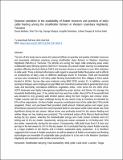| dc.description.abstract | The aim of this study was to assess the seasonal effects on quantity and quality of fodder resources and associated utilization practices among smallholder dairy farmers in Western Usambara Highlands (WUHs) in Tanzania. The WUHs are among the major milk producing areas under smallholder dairy farming systems (SDFS) in Tanzania. Dry season fodder scarcity is a widespread problem affecting the East African SDFS and has been shown to contribute to over 40% reduction in milk yield. There is limited information with regard to seasonal fodder fluctuation and its effects on productivity of dairy cows in different landscape levels of Tanzania. Field and household surveys were conducted in 150 dairy cattle farming households from five villages in three wards located in WUHs. Survey data were analyzed using IBM SPSS version 21. In addition, remote sensing techniques were employed on gap-filled and smoothed Landsat data to generate land cover maps and bimonthly normalized difference vegetation index-time series for the 2009-2016. SDFS landscape was highly heterogeneous typified by crops, bushes, and forests. On average, the household landholding was 1.3 ha, while herd size was three cattle. About 87% of household land was devoted to crop growing with limited pasture along the farm margins and contour strips. Fodder scarcity was the major challenge during the dry season (July to October) as indicated by 87% of the respondents. On-farm fodder resources contributed most of the cattle diet (73%) while rangeland, forest, and purchased feed provided small amount. Natural pasture and napier grass (Pennisetum purpureum) were the most important feeds in wet season while maize stover was most significant during the dry season. Maize stover was profusely stored for dry season feeding and neither silage nor hay making was practiced. The nutritional values of the fibrous feeds declined during the dry season, whereby the metabolizable energy and crude protein contents were 6.0 MJ/kg and 10.1% dry matter, respectively, during wet season compared to 4.8 MJ/kg and 7.8% dry matter, respectively, during the dry season. Consequently, milk yield drops from 5.6 l per cow per day in the wet season to 3.0 l in the dry season. It is concluded that dry season fodder scarcity is a major problem in the WUHs and it hinders sustainable dairy production. It is therefore suggested that increase in fodder production as well as adoption of fodder conservation and feeding technologies are inevitable if sustainable dairy production is to be met in the Western Usambara Highlands and elsewhere with similar environments. | en_US |

